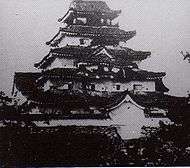Battle of Aizu
| ||||||||||||||||||||||||||||||
The Battle of Aizu (Japanese: 会津戦争, "War of Aizu") was fought in northern Japan in autumn 1868, and was part of the Boshin War.
Aizu was known for its martial skill, and maintained at any given time, a standing army of over 5000. It was often deployed to security operations on the northern fringes of the country, as far north as southern Sakhalin. Also, in the period immediately before, during, and after Commodore Perry's arrival, Aizu had a presence in security operations around Edo Bay.
During the tenure of the 9th generation lord Matsudaira Katamori, the domain deployed massive amounts of their troops to Kyoto, where Katamori served as Kyoto Shugoshoku. Earning the hatred of the Chōshū domain, and alienating his ally, the Satsuma domain, Katamori retreated with the shogun Tokugawa Yoshinobu in 1868.
Though the Satsuma-Chōshū controlled Imperial Court, following Yoshinobu's resignation, called for the punishment of Katamori and Aizu as "enemies of the Court," he took great pains to beg for mercy, finally acquiescing to calls for war later in 1868, during the Boshin War. Though the Aizu forces fought as part of the greater efforts of the Ōuetsu Reppan Dōmei, they were eventually abandoned (after the loss at the Battle of Bonari Pass) by the forces of the former Bakufu under Ōtori Keisuke. Aizu, now fighting alone, had its forces besieged at Tsuruga Castle, the seat of the Aizu domain, in October 1868. This was the start of a month-long siege.
A detached unit from the Byakkotai ("White Tiger Company") — young, predominantly teenage, samurai — are famous for having committed seppuku (a form of ritual suicide) on Mount Iimori, overlooking the castle. Because of the smoke from the burning castle town, which was in between them and the castle itself, they mistakenly assumed that the castle had fallen. Their story is known because of the only one among them whose suicide was unsuccessful: Iinuma Sadakichi.
A remnant of Shinsengumi, a unit which Aizu had supervised while in Kyoto, was present at the battle, under the command of Saitō Hajime.
After a month of siege, Aizu officials agreed to surrender, through the mediation of their neighbor, the Yonezawa Domain. Soon after, Matsudaira Katamori, his son Nobunori, and the senior retainers came before the imperial commanders in person, and offered their unconditional surrender. The samurai population was sent away to prisoner of war camps, and the Aizu domain, as it had been since the mid-17th century, ceased to exist.
-

Burnt down castle of Shirakawa-Komine, during the Battle of Aizu.
-

The damaged Aizu-Wakamatsu castle right after the Battle of Aizu
-
Reenactment of Aizu cannoneers during the Boshin war.
-
Byakkotai warriors
-
Reenactment of young Aizu warriors during the Boshin war.
References
- Noguchi Shinichi, Aizu-han. Tokyo: Gendai Shokan, 2005. (ISBN 4-7684-7102-1)
- Byakkotai.net

